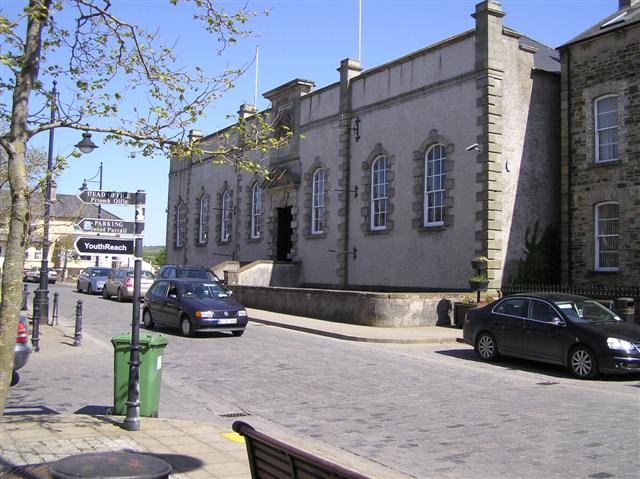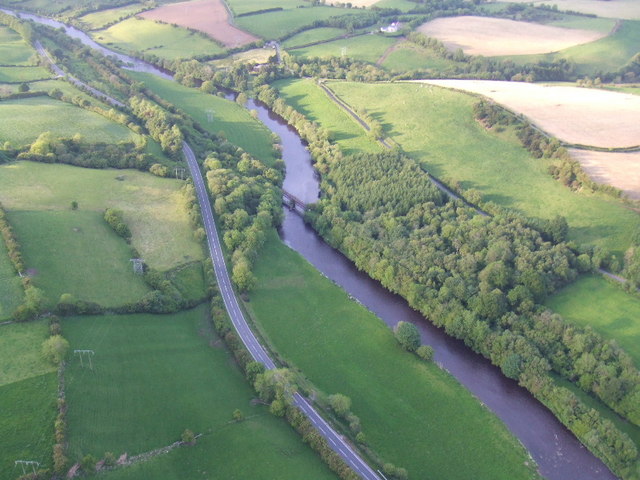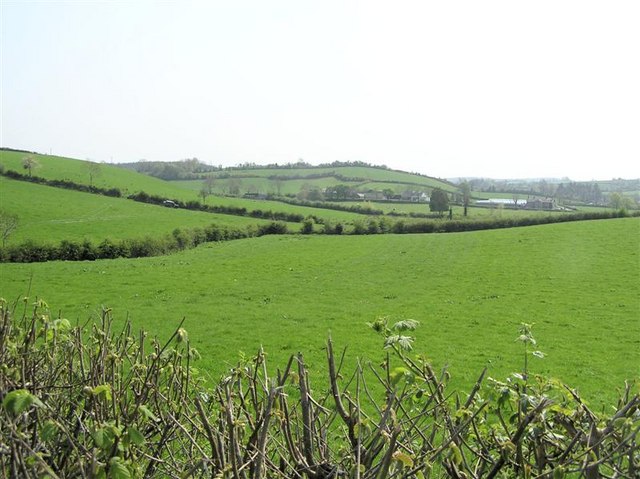|
Porthall
Porthall () is a village and townland in County Donegal, Ireland. The village is located on the west bank of the River Foyle, in The Laggan district of East Donegal, on the R265 road. The nearest town is Lifford, the county town. History Battle of Binnion Hill The Battle of Binnion Hill was fought in 1557 just a short distance from Porthall, approx. 2.5 miles (4 kilometres) North West. The battle came about when John O’Neill, the Grandson of Con O’Neill assembled an army to attack Tirconnell, modern day County Donegal. O’Neill's plan was to defeat Manus O'Donnell from the Kinel-Connell and thus be the only King in Ulster. On the O’Neills side were people from Oriel, modern day Counties Armagh, Louth and Monaghan and from Dundalk, County Louth, also part of O’Neill's army was Hugh O’Donnell (brother of Calvagh) and his followers. The Kinel-Connell was in turmoil at this time as Calvagh O'Donnell had his father locked up for two years so that he himself could be ... [...More Info...] [...Related Items...] OR: [Wikipedia] [Google] [Baidu] |
River Foyle
The River Foyle () is a river in west Ulster in the northwest of the island of Ireland, which flows from the confluence of the rivers Finn and Mourne at the towns of Lifford in County Donegal, Republic of Ireland, and Strabane in County Tyrone, Northern Ireland. From here it flows to the city of Derry, where it discharges into Lough Foyle and, ultimately, the Atlantic Ocean. The total length of the River Foyle is . The river separates part of County Donegal from parts of both County Londonderry and County Tyrone. The district of County Donegal that borders the western bank of the River Foyle is traditionally known as the Laggan. This district includes the villages of St Johnston and Carrigans, both of which are nestled on the banks of the River. Tributaries The Burn Dale (also known as the Burn Deele or the River Deele) flows into the River Foyle on the northern outskirts of Lifford, while the Swilly Burn flows into the Foyle near Porthall, a hamlet between St Johnsto ... [...More Info...] [...Related Items...] OR: [Wikipedia] [Google] [Baidu] |
Lifford
Lifford (, historically anglicised as ''Liffer'') is the county town of County Donegal, Ireland, the administrative centre of the county and the seat of Donegal County Council, although the town of Letterkenny is often mistaken as holding this role. Lifford lies in the River Finn (County Donegal), Finn Valley area of East Donegal where the River Finn (County Donegal), River Finn meets the River Mourne to create the River Foyle. The Burn Dale (also spelt as the Burn Deele), which flows through Ballindrait, flows into the River Foyle on the northern outskirts of Lifford. The original Irish language, Irish name for the town was Leith Bhearr which can be translated as 'Half or Grey water', a description of the nearby river. History The town grew up around a castle built there by Manus O'Donnell, Manghus Ó Domhnaill, ruler of Tír Chonaill (mostly modern County Donegal), in the 16th century. It later became a British Army garrison, garrison town until most of Ireland won indep ... [...More Info...] [...Related Items...] OR: [Wikipedia] [Google] [Baidu] |
County Town
In Great Britain and Ireland, a county town is usually the location of administrative or judicial functions within a county, and the place where public representatives are elected to parliament. Following the establishment of county councils in England in 1889, the headquarters of the new councils were usually established in the county town of each county; however, the concept of a county town pre-dates these councils. The concept of a county town is ill-defined and unofficial. Some counties in Great Britain have their administrative bodies housed elsewhere. For example, Lancaster, Lancashire, Lancaster is the county town of Lancashire, but the county council is in Preston, Lancashire, Preston. Owing to the creation of Unitary authorities of England, unitary authorities, some county towns in Great Britain are administratively separate from the county. For example, Nottingham is separated from the rest of Nottinghamshire, and Brighton and Hove is separate from East Sussex. On a ce ... [...More Info...] [...Related Items...] OR: [Wikipedia] [Google] [Baidu] |
County Tyrone
County Tyrone (; ) is one of the six counties of Northern Ireland, one of the nine counties of Ulster and one of the thirty-two traditional counties of Ireland. Its county town is Omagh. Adjoined to the south-west shore of Lough Neagh, the county covers an area of , making it the largest of Northern Ireland's six counties by size, and the second largest county in Ulster after Donegal. With a population of 188,383 as of the 2021 census, Tyrone is the 5th most populous county in both Northern Ireland and Ulster, and the 11th most populous county on the island of Ireland. The county derives its name and general geographic location from Tír Eoghain, a Gaelic kingdom under the O'Neill dynasty which existed until the 17th century. Name The name ''Tyrone'' is derived from the Irish , meaning 'land of Eoghan', the name given to the conquests made by the from the provinces of and Ulaid. Historically, it was anglicised as ''Tirowen'' or ''Tyrowen'', which are closer to the Irish ... [...More Info...] [...Related Items...] OR: [Wikipedia] [Google] [Baidu] |
Strabane
Strabane (; ) is a town in County Tyrone, Northern Ireland. Strabane had a population of 13,507 at the 2021 United Kingdom census, 2021 census. This article contains quotations from this source, which is available under th Open Government Licence v3.0 © Crown copyright. It lies on the east bank of the River Foyle. It is roughly midway from Omagh, Derry and Letterkenny. The River Foyle marks Irish border, the border between Northern Ireland and the Republic of Ireland. On the other side of the river (across Lifford Bridge) is the smaller town of Lifford, which is the county town of County Donegal, Donegal. The River Mourne flows through the centre of the town and meets the River Finn (County Donegal), Finn to form the Foyle River. A large hill named Knockavoe, which marks the beginning of the Sperrins, Sperrin Mountains, forms the backdrop to the town. History Early history The locale was home to a group of northern Celts known as the Orighella as far back as the fourth cen ... [...More Info...] [...Related Items...] OR: [Wikipedia] [Google] [Baidu] |
O'Neill Dynasty
The O'Neill dynasty ( Irish: ''Ó Néill'') are a lineage of Irish Gaelic origin that held prominent positions and titles in Ireland and elsewhere. As kings of Cenél nEógain, they were historically one of the most prominent family of the Northern Uí Néill, along with the O'Donnell dynasty. Some O'Neills state that their ancestors were kings of Ailech during the Early Middle Ages, as descendants of Niall of the Nine Hostages. Two of their progenitors were High Kings of Ireland: Niall Glúndub (from whom they take their name) and Domnall ua Néill. From 1232 until 1616, the O'Neills were sovereign kings of Tír Eógain, holding territories in the north of Ireland in the province of Ulster, particularly around modern County Tyrone, County Londonderry and County Antrim, in what is now Northern Ireland. After their territory was merged with the Kingdom of Ireland and the land was caught up in the Plantation of Ulster, they were involved in a number of events, such as Tyr ... [...More Info...] [...Related Items...] OR: [Wikipedia] [Google] [Baidu] |
O'Donnell Dynasty
The O'Donnell dynasty ( or ''Ó Domhnaill,'' ''Ó Doṁnaill'' ''or Ua Domaill;'' meaning "descendant of Dónal") were the dominant Irish clan of the kingdom of Tyrconnell in Ulster in the north of medieval and early modern Ireland. Naming conventions Origins Like the family of O'Neill, that of O'Donnell of Tyrconnell was of the Uí Néill, i.e. descended from Niall of the Nine Hostages, High King of Ireland at the beginning of the 5th century; the O'Neill, or Cenél nEógain, tracing their pedigree to Eógan mac Néill, and the O'Donnells, or Cenél Conaill, to Conall Gulban, both sons of Niall. Conall was baptised by St. Patrick. Arms and motto The Roman Emperor Constantine the Great converted to Christianity after a vision before the famous Battle of the Milvian Bridge, having seen a chi-rho in the sky, and thence the motto '' In Hoc Signo Vinces'', telling him he would be victorious with the sign of the cross. The chi-rho was adopted on a banner, the lab ... [...More Info...] [...Related Items...] OR: [Wikipedia] [Google] [Baidu] |
Calvagh O'Donnell
Calvagh O'Donnell (; 26 October 1566), eldest son of Manus O'Donnell, was an Irish King of Tyrconnell of the mid-16th century. He was Rí, king and chief of the O'Donnell dynasty based in Tyrconnell in western Ulster. He is best known for his conflict with Shane O'Neill (son of Conn), Shane O'Neill – a dispute that involved the intervention of the English government in Ireland on Calvagh's side. Life Calvagh O'Donnell was the eldest son of Manus O'Donnell by his first wife, Joan O'Reilly. In the course of a quarrel with his father and his half-brother Hugh, Calvagh sought aid in Scotland from the Campbells, who with access to Scottish royal artillery were able to assist him in deposing Manus and securing the now very divided lordship of Tyrconnell for himself. Hugh then appealed to Shane O'Neill (Irish chieftain), Shane O'Neill, chief of the neighbouring O'Neill dynasty, to restore him at Calvagh's expense. Shane accordingly invaded Tyrconnell at the head of a large army in 1557, ... [...More Info...] [...Related Items...] OR: [Wikipedia] [Google] [Baidu] |
County Louth
County Louth ( ; ) is a coastal Counties of Ireland, county in the Eastern and Midland Region of Republic of Ireland, Ireland, within the Provinces of Ireland, province of Leinster. Louth is bordered by the counties of County Meath, Meath to the south, County Monaghan, Monaghan to the west, County Armagh, Armagh to the north and County Down, Down to the north-east, across Carlingford Lough. It is the List of Irish counties by area, smallest county in Ireland by land area and the List of Irish counties by population, 17th most populous, with just over 139,100 residents 2022 census of Ireland, as of 2022. The county is named after the village of Louth, County Louth, Louth. Louth County Council is the Local government in the Republic of Ireland, local authority for the county. History County Louth is named after the Louth, County Louth, village of Louth, which in turn is named after Lugh, a god of the ancient Irish. Historically, the placename has had various spellings; , , and ( ... [...More Info...] [...Related Items...] OR: [Wikipedia] [Google] [Baidu] |
Dundalk
Dundalk ( ; ) is the county town of County Louth, Ireland. The town is situated on the Castletown River, which flows into Dundalk Bay on the north-east coast of Ireland, and is halfway between Dublin and Belfast, close to and south of the border with Northern Ireland. It is surrounded by several townlands and villages that form the wider Dundalk Municipal District. It is the seventh largest List of urban areas in the Republic of Ireland, urban area in Ireland, with a population of 43,112 as of the 2022 census of Ireland, 2022 census. Dundalk has been inhabited since the Neolithic period. It was established as a Normans, Norman stronghold in the 12th century following the Norman invasion of Ireland, and became the northernmost outpost of The Pale in the Late Middle Ages. Located where the northernmost point of the province of Leinster meets the province of Ulster, the town came to be known as the "Gap of the North". The modern street layout dates from the early 18th century and ... [...More Info...] [...Related Items...] OR: [Wikipedia] [Google] [Baidu] |
County Monaghan
County Monaghan ( ; ) is a Counties of Ireland, county in Ireland. It is in the Provinces of Ireland, province of Ulster and is part of Border Region, Border strategic planning area of the Northern and Western Region. It is named after the town of Monaghan. Monaghan County Council is the Local government in the Republic of Ireland, local authority for the county. The population of the county was 65,288, according to the 2022 census. The county has existed since 1585 when the Mac Mathghamhna rulers of Airgíalla agreed to join the Kingdom of Ireland. Following the 20th-century Irish War of Independence and the signing of the Anglo-Irish Treaty, Monaghan was one of three Ulster counties to join the Irish Free State rather than Northern Ireland. Geography and subdivisions County Monaghan is the fifth-smallest of the Republic's 26 counties by area, and the fourth smallest by population. It is the smallest of Ulster's nine counties in terms of population. Baronies * Cremorne (ba ... [...More Info...] [...Related Items...] OR: [Wikipedia] [Google] [Baidu] |
County Armagh
County Armagh ( ) is one of the six counties of Northern Ireland and one of the traditional thirty-two counties of Ireland. It is located in the Provinces of Ireland, province of Ulster and adjoins the southern shore of Lough Neagh. It borders the Northern Irish counties of County Tyrone, Tyrone to the west and County Down, Down to the east. The county borders County Louth, Louth and County Monaghan, Monaghan to the south and southwest, which are in the Republic of Ireland. It is named after its county town, Armagh, which derives from the Irish language, Irish ''Ard Mhacha'', meaning "Macha's height". Macha was a sovereignty goddess in Irish mythology and is said to have been buried on a wooded hill around which the town of Armagh grew. County Armagh is colloquially known as the "Orchard County" because of its many apple orchards. The county covers an area of , making it the smallest of Northern Ireland's six counties by size and the List of Irish counties by area, sixth-smallest ... [...More Info...] [...Related Items...] OR: [Wikipedia] [Google] [Baidu] |









